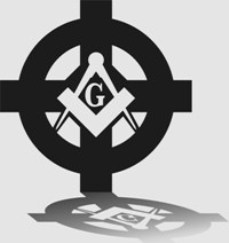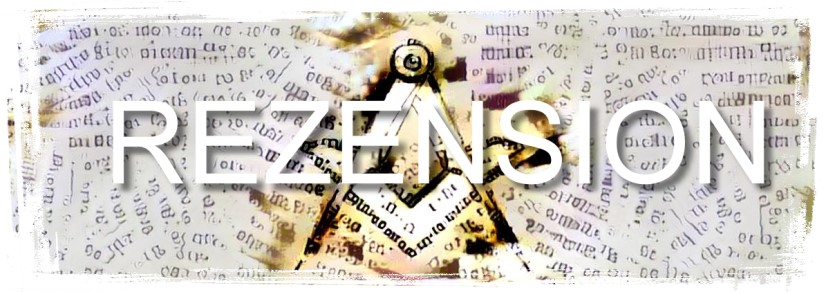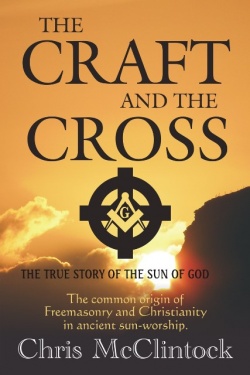Chris McClintock - The Craft And The Cross
Der Autor
Chris McClintock ist seit 1991 Freimaurer und Mitglied der Irischen Forschungsloge. Seit 2005 ist er der Meister vom Stuhl der irischen Lodge No 754 Coleraine. Sein Hauptberuf ist die Restauration von Bleiglas-Fenstern an Sakralbauten in Irland. Dokumentationen über diese Arbeit wurden von RTE in Dublin und von BBC Radio Ulster veröffentlicht. Sein Hauptinteresse gilt der historischen Forschung, insbesondere der astronomischen Ausrichtungen der alten Megalith-Kulturen in Irland und Schottland sowie der keltischen Folklore, die um sie herum entstanden ist. Ausführlich Forschungsreisen führten ihn in Irland und Schottland auf der Suche nach Megalith-Kulturen, deren Ausrichtungen und zusehr alten Kirchen. Er schätzt die Arbeit von Prof. Alexander Thom und dessen bahnbrechende Arbeiten in der Wissenschaft der Archäo-Astronomie.
Neuland
Mit dieser Seite betritt das Freimaurer-Wiki abermals Neuland. Viele Publikationen über Freimaurerei werden über mitgelieferte Zitations-Angebote der Verlage perpetuierend aus einem vorgegebenen Blickwinkel rezensiert. Man kann das gut bei den Amazon-Buchbesprechungen beobachten. Jede nachfolgende Bewertung reflektiert die zuvor veröffentlichte Meinung. Selbstverständlich gibt es Bücher, die polarisieren. Divergierende Positionen können durchaus auch im Sinne des Verlages sein. Darin ist also per se nichts Negatives auszumachen.
Um das Freimaurer-Wiki aber nicht zu einem Forum zu machen, weisen wir noch einmal ausdrücklich auf die Möglichkeit hin, den Bereich Diskussion zu jedem einzelnen Thema in diesem Freimaurer-Wiki zu nutzen.
Aus diesem Meinungs-Schema wählen wir dann repräsentative Darstellungen aus und stellen sie in die Rezensions-Bereiche.
"The Craft and the Cross"
 Zum Auftakt haben wir ein besonders interessantes Buch des irischen Verlages AESUNPUBLISHING ausgewählt. Schon der Titel "The Craft and the Cross" von Chris McClintock ist schwierig zu übersetzen. Das Wort "Craft" bezeichnet einerseits das Kunsthandwerk allgemein, bekommt aber im freimaurerischen Kontext eine erweiterte Bedeutung, steht für Dombaukunst und letztlich für die Freimaurerei selbst. Wilhelm Begemann übersetzt es mit "Zunft" ein anderes Mal mit "Kunst", es ist also auch durchaus als "Königliche Kunst" zu interpretieren. Roland Müller schlägt treffende Titelübersetzungen wie "Das Symbol des Kreuzes und die Freimaurer" oder "Freimaurerei und das Symbol des Kreuzes". Er merkt jedoch auch an, daß diese Lösung zwar nahe am Inhalt sei, aber vermutlich zu schwerfällig klingt. Wir arbeiten also noch an einer griffigen Titel-Übersetzung.
Zum Auftakt haben wir ein besonders interessantes Buch des irischen Verlages AESUNPUBLISHING ausgewählt. Schon der Titel "The Craft and the Cross" von Chris McClintock ist schwierig zu übersetzen. Das Wort "Craft" bezeichnet einerseits das Kunsthandwerk allgemein, bekommt aber im freimaurerischen Kontext eine erweiterte Bedeutung, steht für Dombaukunst und letztlich für die Freimaurerei selbst. Wilhelm Begemann übersetzt es mit "Zunft" ein anderes Mal mit "Kunst", es ist also auch durchaus als "Königliche Kunst" zu interpretieren. Roland Müller schlägt treffende Titelübersetzungen wie "Das Symbol des Kreuzes und die Freimaurer" oder "Freimaurerei und das Symbol des Kreuzes". Er merkt jedoch auch an, daß diese Lösung zwar nahe am Inhalt sei, aber vermutlich zu schwerfällig klingt. Wir arbeiten also noch an einer griffigen Titel-Übersetzung.
Der Untertitel verspricht die wahre Geschichte der "Gottessonne" in einem wunderbaren Wortspiel, das sich im Ursprung phonetisch als "Gottessohn" interpretieren lässt und weist damit auf eine überaus interessante Sichtweise hin, wie sie bereits im Buch "Bloodline of the holy grail" von Laurence Gardner auftaucht. Dort wurde sie möglicherweise willentlich falsch interpretiert.
Ein besonderer Schwerpunkt des Buches ist jedoch der Sonnenkult der keltischen Druiden, deren Ausformung am Rande des europäischen Kontinents zu einer eigenständigen Symbolik führte. Präzise astronomische kenntnisse führten zu einer Ikonographie, die zum Teil zwar von der römisch katholischen Kirche adaptiert , deren Ursprünge aber in einen eigenen Deutungskontext überführt wurden.
Auf den Arbeitstafeln der Freimaurer sind die Ursprünge erhalten, ihre Bedeutung ist jedoch nur wenigen Freimaurern bewusst. Chris MacClintock hat es sich zur Aufgabe gemacht, den Ursprung freimaurerischer Symbolik zu erläutern.
Rezensionen
Text folgt / site under construction
Links
Verlagsankündigung
In englischer Sprache: (Bitte übersetzen)
The Craft and the Cross examines the birth of sacred symbolism in pre-Christian times and traces its development and survival into the modern world.
This study is the result of a quest to understand the symbols of Freemasonry, and reveals for the first time ever what the obscure allegories actually mean. In coming to understand the true meaning of the rituals and symbols of Freemasonry a picture emerges that is both controversial and unexpected, for it shows a common origin of both the symbols of the Craft and those of Christianity. And that common origin is the ancient veneration of the sun.
The book takes as a starting point an examination of the present day rituals and symbols of Freemasonry, where a radical new interpretation of that symbolism uncovers many allegorical references to the sun and the rhythm of the seasons lying forgotten within. That symbolism is discovered to be truly ancient, originating over four thousand years ago among the Bronze Age peoples of the British Isles.
The people who then inhabited the north-western edge of the ancient world venerated the sun above all else and regarded its four rising and setting points on the solstices - and the cross they form on the ground - as sacred. Thus the cross of the sun was sacred for thousands of years before the arrival of Christianity, and it is the contention of the author that as Christianity arose the dispossessed Druids who upheld this knowledge were absorbed into the new faith - carrying their more ancient understanding of the cross with them.
The version of Christianity developed by those Druids is known as The Celtic Church and existed as an autonomous part of Christianity quite separate from the influence of Rome until the 12th Century when the papacy finally moved to bring it into the fold. Evidence is presented that shows that though the Celtic Church faded from the pages of history it's esoteric teachings survived their overthrow and emerged as the Craft in the 17th Century.
‘The Craft and the Cross’ traces the path of this secret knowledge right from its formulation in the distant past, through the arrival of Christianity and the merging of the old with the new, and uncovers it's continued existence today, in the largest and most enigmatic brotherhood in the world - Freemasonry!
It also shows that whilst Freemasonry carries symbolism that can be regarded as having a pagan origin, many of the symbols of Christianity were derived from the very same source.
Whilst the Craft is no longer aware of the immense history that lies in its own rituals, that history is still nevertheless there, and has been newly reconstructed by the author from the minute observation of the labours of the lodge room.
The Craft and the Cross tells that story.
Weitere Bücher zum Thema
Die vorgestellten Bücher stellen nicht in jedem Fall eine Referenz dar.
Weitere Rezensionen im Freimaurer-Wiki
- Rezension: Freimaurerei für Dummies
- Rezension: Dan Brown - Das verlorene Symbol
- Rezension: Im Schatten des Eroberers
- Rezension: Freimaurerei heute - Lebens- und Geisteshaltung
- Rezension: Die Freimaurer im alten Preussen
- Rezension: Michael Kraus - Die Freimaurer
- Rezension: Freimaurerei und Ethik
- Rezension: Philosophie der Freimaurerei
- Rezension: Freimaurerei - weltbekannt und doch geheimnisvoll
- Rezensionen: Freimaurerische Kunst
- Rezension: Alle Menschen werden Schwestern und Brüder
- Rezension: Typologien des Verschwörungsdenkens




